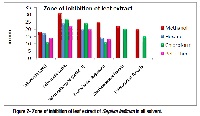Phytochemical Investigation and Antibacterial activity of leaf and stem extracts of Sapium indicum Linn
Keywords:
Mangrove, Sapium indicum, phytochemical screening, antimicrobial activityAbstract
Plants have provided a source of inspiration for novel drugs compounds. In this study, the antibacterial activity was of Sapim indicum Linn. collected from mangroves area of Odisha was made against some bacterial pathogens by disc diffusion method. All the four crude extracts (methanol, chloroform, hexane, and petroleum ether) tested, showed significant antimicrobial activity with zone of inhibitions ranging between 9-31 mm. Among all the solvent, methanol extracts of both stem and leaf exhibited the highest inhibition zone against Salmonella typhi. Further evaluation of minimal inhibitory concentration (MIC) showed values ranging from 4-5.6 mg/ml. Preliminary phytochemical screening revealed the presence of alkaloids, steroids, triterpenoids, saponins, flavonoids, reducing sugars and protein in almost all extract. The present study of in vitro antibacterial assay and preliminary phytochemical analysis may open new vistas for identifying potential bioactive molecules for chemical, pharmacological and herbal industry.
References
. Abraham Z. Glimpses of Indian Ethno
botany, Oxford & Publishing Co.,
New Delhi, 1981; 308-320.
. Holiman A. Plants in Medicine.
Chelsea Physic Garden. The
Chelsea Physic Garden Co Ltd.
. Cowan MM. Plant products as
antimicrobial agents. Clinical
microbiology reviews, 1999; 1 (2):
-82.
. Duraipandiyan V, Ayyanar M,
Ignacimuthu S. Antimicrobial Activity
of Some Ethnomedical Plants Used
by Paliyar Tribe from Tamil Nadu,
India. BMC complementary and
alternative medicine. 2006; 635.
. Premnathan M, Chandra K, Bajpai
SK, Kathiresan K. A survey of some
Indian Marine plants for antiviral
activity. Bot. Mar. 1992; 35: 321-
. Premnathan M, Nakashima H,
Kathiresan K, Rajendra N,
Yamamoto N. In Vitro antihuman
immunodeficiency virus activity of
mangrove plants. Indian Journal of
Medicinal Research, 1996; 103:
-281.
. Kokpal V, Miles DH, Payne AM,
Chittarwong V. Chemical
constituents and bioactive
compounds from mangrove plants.
Studies in Natural products
Chemistry. 1990; 7: 175-199.
. Das DK, Alam MK. Trees of
Bangladesh. Bangladesh forest
research institute. 2001.
. Saxena HO, Bramham M. The Flora
of Orissa.1st Edn, Vol.3 OFDC Ltd.
; 427 – 431.
. Sofowara AE. Medicinal Plants and
traditional medicine in Africa.
Spectrum books Limited, Ibadan,
Nigeria. 1993: 288-289.
. Edeoga HO, Okwa DE, Mbaebie
BO. Phytochemical constituents of
some Nigerian medicinal plants.
African Journal of Biotechnology,
; 4(7): 685-688.
. Kumar AR, Subburathinam KM,
Prabakar G. Phytochemical
screening of selected medicinal
plants of Asclepiadaceae family.
Asian Journal of Microbiology,
Biotechnolology and Environmental
Sciences, 2007; 9(1): 177-180.
. Bauer AW, Kirby WMM, Sherries
JC, Tuck M. Antibiotic testing by a
standardized disc diffusion method.
Am J.Clin. Pathol, 1966. 45: 493-
. World Health Organization.
Guidelines for the assessment of
herbal medicines. Programme on
traditional medicines, WHO,
Geneva, 1991; 4.
. Edwards MC, Taylor SE, Williamson
EM, Evans FJ. Acta Pharmacol.
Toxicol., 1983; 53: 177-187.
. Taylor SE, Evans FJ, Gafur MA,
Choudhury AK. J. Nat. Prod., 1981;
: 729-731.
. Taylor SE, Gafur MA, Choudhury
AK, Evans F. J.Tetrahedron Lett.,
; 22: 3321-3324.
. Taylor SE, Gafur MA, Choudhury
AK, Evans F. J. Phytochemistry,
; 20: 2749-2751.
. Taylor SE, Gafur MA, Choudhury
AK, Evans F. J. Phytochemistry,
; 21: 405-407.
. Alam S. Antimicrobial activity of
natural products from medicinal
plants. Gomal Journal of Medical
Sciences, 2009; 7.
. Baldemir AM, Coskun, Yildiz S.
Antimicrobial activity of Ferula
halophla pesmen. FABAD
Journal of Pharmacy Science, 2006;
:57-61.
. Gurinder JK, Daljit SA. In vitro
antibacterial activity of three plants
belonging to the family Umbelliferae.
International Journal Antimicrob
Agent, 2008; 31: 380-399.
. Khanahmadi M, Rezazadeh SH,
Taran M. In vitro Antimicrobial and
Antioxidant Properties of Smyrnium
cordifolium Boiss. (Umbelliferae)
Extract. Asian Journal of plant
Science 2010; 9(2): 99 103.
. Lopez P, Sanchez C, Batlle R, Nerin
C. Solid and vapor phase
antimicrobial activities of six
essential oils: susceptibility of
selected food borne bacterial and
fungal strains. Journal of Agricultural
and Food Chemistry, 2005;
:6939-6946.



